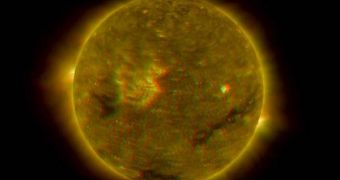An inter-agency panel of experts in the United States has calculated a prediction number of Solar Cycle 24, the 11-year time frame we are in now. This is, obviously, the 24th cycle since humans began to take notice of the repeating patterns of solar activities, and, according to estimates, it will peak in May 2013, with a below-average sunspot intensity. That is to say, as opposed to SC23, it will be a lot calmer. In addition, we can expect at least another full year of relatively low activity from the star, which means that the astronauts aboard the ISS, the satellite network around the planet, and the power grids on it are safe from the harmful effects of solar radiation for now.
“If our prediction is correct, Solar Cycle 24 will have a peak sunspot number of 90, the lowest of any cycle since 1928 when Solar Cycle 16 peaked at 78,” NOAA Space Weather Prediction panel Chairman Doug Biesecker, from Boulder, Colorado, said. The new study was conducted by the National Oceanic and Atmospheric Administration (NOAA) and sponsored by the space agency NASA. Its 12-member panel featured experts from nine different government agencies and academic institutions.
Still, the fact that the Sun will not be very active during this cycle doesn't mean much, in terms of guaranteeing our safety. “Even a below-average cycle is capable of producing severe space weather. The great geomagnetic storm of 1859, for instance, occurred during a solar cycle of about the same size we’re predicting for 2013,” Biesecker warned. According to estimates, if a similar storm hit us today, it would cause between $1 and $2 trillion in damages. It would also take about four to ten years for repairs to the high-tech infrastructure to be done.
Previous estimates of SC24 stated that the solar maximum could come either in 2011 or in 2012, but the new research proved all wrong. “It turns out that none of the models were really correct. The sun is behaving in an unexpected and very interesting way,” NASA’s lead representative on the investigation panel, Dean Pesnell, shared. He works out of the Goddard Space Flight Center, in Greenbelt, Maryland. “In our professional careers, we’ve never seen anything quite like it. Solar minimum has lasted far beyond what we predicted in 2007.”

 14 DAY TRIAL //
14 DAY TRIAL //